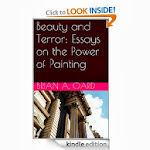Here, in no particular order, are fifteen essential books to form the foundation of a great library on Euro-North African-Middle Eastern-Western Hemispheric art (that topic formerly and Eurocentrically called 'Western Art').
1. The Shock of the New by Robert Hughes. It's tough to choose just one book by the late, great Robert Hughes. American Visions is later and bigger, vaster than Nebraska; his Goya book and the collection Nothing If Not Critical are equally essential. These are all books that will teach you something new every time you re-read them.
2. Selected Essays by John Berger. The same is true of John Berger's wonderful essays, in which the text of art often becomes a pretext for investigating questions as deep as the meanings and meaninglessness of life. Berger is our time's heir to Ruskin and Pater.
3. The Renaissance by Walter Pater. The unholy bible of Aestheticism. Don't read The Renaissance for facts; much of Pater's scholarship has been discredited by subsequent research. Come here to bathe in the most beautiful critical prose in the language, to luxuriate in a sensibility that has the power to transform your own.
4. The Art Criticism of John Ruskin (edited by Robert Herbert). Pater's equal in prose talent and opposite in virtually everything else, the ridiculously influential Mr. Ruskin composed beautiful, interminable prose poems on the paintings of Turner and Venetian Gothic architecture. Everyman's Library or the Modern Library needs to bring out complete multi-volume editions of Modern Painters and The Stones of Venice. Until they do (or more likely, since they won't), this old 'greatest hits' selection is a good bet.
5. The Arcades Project by Walter Benjamin. Neither a work of criticism (although it contains many marvelous insights) nor an anthology (although it consists largely of an encyclopedic collection of quotations), this is a High Modernist, poetically structured work of critical theory that reads like a fragmented archaeological survey of Paris after the bomb that never fell. There is nothing remotely like it in the critical canon.
6. A Life of Picasso by John Richardson (3 volumes, 4th in progress). The 20th century's greatest artist, a titan who revolutionized not only painting, not only sculpture, but also pottery and graphic arts, richly deserves one of the greatest artist biographies ever written, and that is exactly the gift John Richardson is presenting to his old friend. Richardson has his likes and dislikes among Picasso's circles of friends, and he can be bitchy at times (witness his stinging treatment of Gertrude Stein), but none of that alters these facts: the first volume of this bio will change the way you think about Picasso, and the second is the best narrative history of Cubism ever written.
7. Impressionism: Art, Leisure and Parisian Society by Robert L. Herbert. This is THE book on Impressionism. Herbert is a social historian with an artist's eye, his every interpretation grounded in the act of looking closely at paintings. This is refreshing in an age that thinks art interpretation should begin
(and even end) with readings in critical theory.
8. The Social History of Art by Arnold Hauser (4 volumes). Read Hauser's four volumes and then visit a great art museum. You will have the uncanny experience of walking through Arnold Hauser's head. This is one of the last century's fundamental artworld texts.
9. A Humument by Tom Phillips. The book as work of art. Many years ago, London artist Tom Phillips (he painted the wonderful portrait of Iris Murdoch in the National Portrait Gallery, London) purchased a copy of a forgotten Victorian novel and proceeded to wonderfully deface it, turning each page into a small painting that includes fragments of the original text producing an effect of aleatoric poetry.
10. Night Studio: A Memoir of Philip Guston by Musa Mayer. The most important 'artist's offspring memoir' since Jean Renoir's, this book is rich with invaluable insights into Guston and his art. The quotations from Guston's journals are a highpoint.
11. History of Art by H. W. Janson and Anthony F. Janson. This is the best introductory textbook for Western Art, a huge, beautifully illustrated survey of art from cave paintings to Cindy Sherman. The illustrations alone are worth the price.
12. The Nude by Kenneth Clark. A once groundbreaking book that has, over the years, become a victim of its own success--its original categories and distinctions so influential that they've become curatorial clichés--Clark's Nude is still essential reading for anyone who wishes to look literately at paintings.
13. Letters on Cezanne by Rainer Maria Rilke. A great poet's raw reactions upon discovering a great painter. Picasso and Braque also attended this Cezanne exhibition, which decisively influenced Cubism.
14. Techniques of the Great Masters of Art by David A. Anfam, et al. This apparently little-known book is an invaluable reference for artists, art critics and art forgers. It tells in massively illustrated detail how artist's from Giotto to Lucien Freud created their paintings.
15. The Lives of the Artists by Giorgio Vasari. Vasari was a bootlicking Medici propagandist and he got just about every fact in his book wrong, but his capsule biographies remain delightful as works of art. Read this book as though it were written by Borges. It might have been.
Wednesday, March 23, 2016
Subscribe to:
Post Comments (Atom)










No comments:
Post a Comment